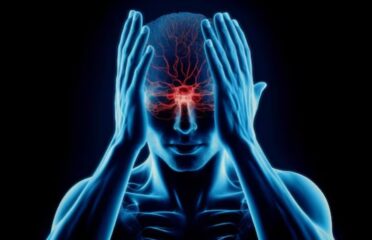Acute Disseminated Encephalomyelitis
Overview

Acute disseminated encephalomyelitis (ADEM) is a serious autoimmune disorder that affects the central nervous system.
It rapidly progresses and causes demyelination in the brain, spinal cord, and sometimes the optic nerve due to inflammation triggered by a previous infection or vaccination. Although various infectious agents and immunizations, such as cytomegalovirus, Epstein-Barr virus, and influenza virus, have been associated with ADEM, in most cases, the root cause remains unknown.
In the past, before the widespread use of vaccinations, ADEM was commonly linked to measles.
Symptoms
Symptoms of Acute Disseminated Encephalomyelitis (ADEM):
• Headache: Severe headaches are common in ADEM and can persist, becoming debilitating over time.
• Neurological symptoms: Changes in mental status: Confusion, irritability, disorientation, or coma in severe cases.
• Weakness or paralysis: Limb weakness, muscle weakness, or partial/complete paralysis.
• Visual disturbances: Blurred vision, double vision (diplopia), or vision loss. Sensory changes: Numbness, tingling sensations, or alterations in sensation.
• Coordination difficulties: Lack of coordination or balance problems.
• Seizures: Abnormal electrical activities in the brain causing convulsions, loss of consciousness, or abnormal behaviors.
Causes & Risks
• Infections: ADEM often arises from the immune system reacting to recent viral or bacterial infections, including measles, mumps, rubella, influenza, herpes simplex, Epstein-Barr, and Mycoplasma pneumonia.
• Vaccinations: Rarely, certain vaccines like MMR, influenza, and others have been linked to ADEM. However, the risk post-vaccination is extremely low compared to the risk of the infections themselves.
• Immune Response: ADEM is believed to develop when the immune system, fighting an infection or reacting to a vaccine, mistakenly attacks the body's myelin, causing inflammation, myelin damage, and disrupted nerve signals.
• Risk Factors: Although ADEM can affect any age group, it's more common in children and adolescents. Some individuals may have a genetic predisposition or specific factors making them more susceptible, but these factors are not always clearly defined.
Test & Diagnosis
• Medical History and Physical Examination: Healthcare providers explore symptoms, recent infections, vaccinations, and relevant medical history.
• Neurological Examination: Assess reflexes, muscle strength, coordination, sensation, and cognitive function.
• MRI Scans: Crucial for diagnosis, MRI reveals characteristic inflammation and demyelination patterns in the brain and spinal cord, distinguishing ADEM from other conditions.
• Cerebrospinal Fluid (CSF) Analysis: Lumbar Puncture: Collects and analyzes CSF. Changes, like increased white blood cells or inflammatory markers, support ADEM diagnosis.
• Electroencephalogram (EEG): Brain Activity Measurement: In some cases, EEG gauges electrical activity. Abnormal patterns offer insights into brain function and aid in ruling out other conditions.
• Blood Tests: Rule-Out Screening: Conducted to eliminate potential causes like infections or autoimmune conditions, contributing to the neurological symptoms.
Treatment
• Corticosteroids: High-dose corticosteroids, like intravenous methylprednisolone, serve as the primary treatment, suppressing the immune response causing brain inflammation.
• Intravenous Immunoglobulin (IVIG): IVIG therapy, containing antibodies, may be considered when corticosteroids are insufficient or not tolerated, modulating the immune system and reducing inflammation.
• Plasma Exchange (Plasmapheresis): For cases unresponsive to corticosteroids or IVIG, plasma exchange removes and replaces plasma, eliminating harmful antibodies and inflammatory factors.
• Supportive Care - Tailored Management: Symptomatic treatment includes addressing seizures, pain, and utilizing physical/occupational therapy or rehabilitation for mobility, motor issues, and neurological deficits.
• Immunosuppressive Therapy - Refractory Cases: In severe or refractory instances, immunosuppressive medications like azathioprine, cyclophosphamide, or rituximab may be considered to dampen the immune response.
• Treatment of Underlying Trigger - Addressing Cause: If ADEM is triggered by infection or vaccination, managing the underlying cause is vital for effective ADEM management.
Living With
Living with Acute Disseminated Encephalomyelitis (ADEM) presents varied experiences contingent on severity and treatment outcomes. Individuals with complete recovery or mild symptoms often resume normal life post-acute phase.
However, those facing more severe symptoms may necessitate adjustments. Rehabilitation, including physical, occupational, and speech therapy, addresses lingering deficits, improving motor function and cognition. Regular follow-ups with neurologists monitor neurological status and manage potential complications, ensuring ongoing medical care.
Depending on severity, continuous medication or treatment might be required. Emotional and psychological support becomes crucial, especially for lasting neurological effects, prompting individuals to seek assistance from family, friends, or professionals. Educational and workplace accommodations may be necessary, ensuring participation despite cognitive or physical challenges.
Lifestyle adjustments, encompassing assistive devices or home modifications, help individuals tailor activities to their capabilities.
Complications
• Neurological deficits: Weakness, coordination problems, sensory abnormalities, visual disturbances, speech difficulties, and cognitive impairments may persist, requiring ongoing therapy.
• Seizures: Some individuals might develop seizures during the acute phase or as a long-term complication, varying in type and severity and necessitating specific antiepileptic medications.
• Cognitive impairments: ADEM can affect memory, attention, concentration, and problem-solving, leading to persistent cognitive difficulties requiring rehabilitation or supportive interventions.
• Physical disabilities: Depending on neurological damage, ADEM may result in paralysis, weakness, gait abnormalities, or motor skill difficulties, often requiring rehabilitation and physical therapy.
• Psychological impact: Coping with long-term challenges might lead to emotional distress, anxiety, depression, requiring support from mental health professionals or support groups.
• Complications from treatment: Some ADEM treatments may have potential side effects like increased infection risk, weight gain, mood changes, or osteoporosis, necessitating careful management.

The Content is not intended to be a substitute for professional medical advice, diagnosis, or treatment. Always seek the advice of your physician or other qualified health provider with any questions you may have regarding a medical condition.
Know more about
Our Healthcare Planner
Personal Health Planner at BNC is a support staff who listens to your concerns and connects you with a Neuro Care provider. They prioritize your needs and create a trusting relationship between you and the provider.
Three fundamental values we can assure you:
1. Personalized Healthcare.
2. Most advanced robotic therapies
3. Transparent pricing





